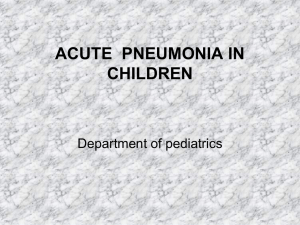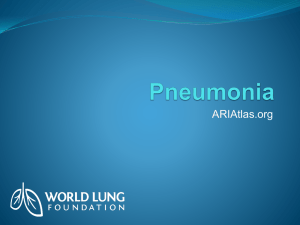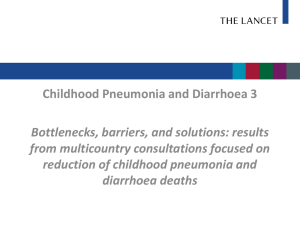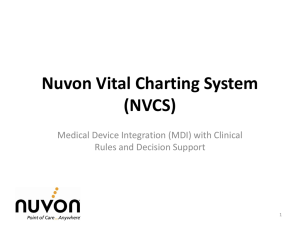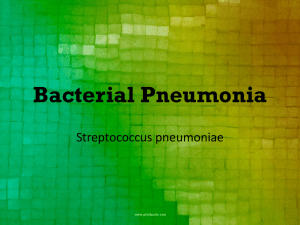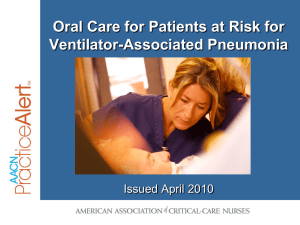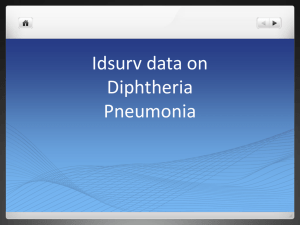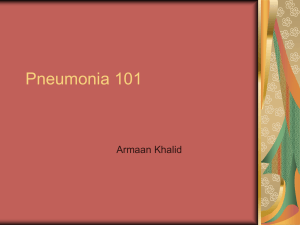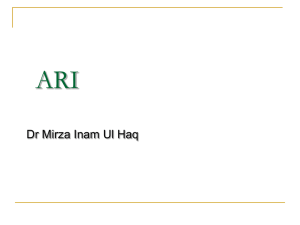Pneumonia
advertisement
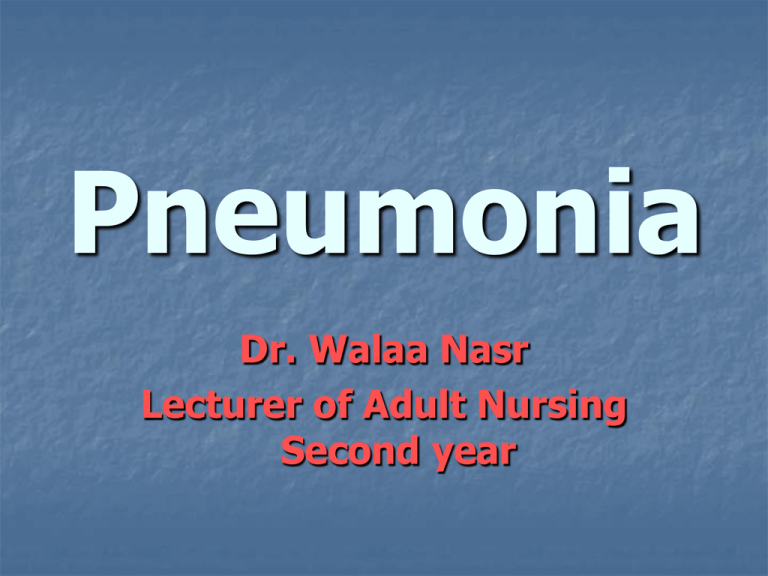
Pneumonia Dr. Walaa Nasr Lecturer of Adult Nursing Second year Out lines Pneumonia Definition Classification of pneumonia According to causes According to area involved Mode of transmission Predisposing factors Pathophysiology Clinical manifestations Diagnostic tests Medical management Nursing intervention Preventive measures Prognosis Complications Pneumonia Definition Is an inflammatory process of the lung parenchyma that is commonly caused by infectious agents. Classification of pneumonia According to causes Bacterial (the most common cause of pneumonia) Viral pneumonia Fungal pneumonia Chemical pneumonia (ingestion of kerosene or inhalation of irritating substance) Inhalation pneumonia (aspiration pneumonia) Classification of pneumonia (cont…) According to areas involved Lobar pneumonia; if one or more lobe is involved Broncho-pneumonia; the pneumonic process has originated in one or more bronchi and extends to the surrounding lung tissue. Pneumonia Mode of transmission Ways you can get pneumonia include: Bacteria and viruses living in your nose, sinuses, or mouth may spread to your lungs. You may breathe some of these germs directly into your lungs (droplets infection). You breathe in (inhale) food, liquids, vomit, or fluids from the mouth into your lungs (aspiration pneumonia). Pneumonia Predisposing factors Immuno-suppresed patients Cigarette smoking Difficult swallowing (due to stroke, dementia,parkinsons disease, or other neurological conditions) Impaired consciousness ( loss of brain function due to dementia, stroke, or other neurological conditions) Pneumonia Predisposing factors Chronic lung disease (COPD, bronchostasis) Frequent suction Other serious illness such as heart disease, liver cirrhosis, and DM Recent cold, laryngitis or flu Pneumonia Pathophysiology The streptococci reach the alveoli and lead to inflammation and pouring of an exudates into the air spaces. WBCs migrates to alveoli, the alveoli become more thick due to its filling consolidation, involved areas by inflammation are not adequately ventilated, due to secretion and edema. This will lead to partial occlusion of alveoli and bronchi causing a decrease in alveolar oxygen content. Pneumonia Pathophysiology (cont…) Venous blood that goes to affected areas without being oxygenated and returns to the heart. This will lead to arterial hypoxemia and even death due to interference with ventilation. Pneumonia Clinical manifestations Shaking chills Rapidly rising fever ( 39.5 to 40.5 degree) Stabbing chest pain aggravated by respiration and coughing Tachypnea, nasal flaring Patient is very ill and lies on the affected side to decrease pain Use of accessory muscles of respiration e.g. abdomen and intercostals muscles Cough with purulent, blood tinged, rusty sputum Shortness of breath Flushed cheeks Loss of appetite, low energy, and fatigue Cyanosed lips and nail beds Pneumonia Diagnostic tests History taking Physical examination Chest x-ray Blood test Sputum culture Pneumonia Medical management Antibiotic, depending on sputum and blood culture Oxygen therapy Chest physiotherapy Pneumonia Nursing intervention Maintain a patent airway and adequate oxygenation. Obtain sputum specimens as needed. Use suction if the patient can’t produce a specimen. perform chest physiotherapy. Pneumonia Nursing intervention (cont…) Provide a high calorie, high protein diet of soft foods. To prevent aspiration during nasogastric tube feedings, check the position of tube, and administer feedings slowly. To control the spread of infection, dispose secretions properly. Pneumonia Nursing intervention (cont…) Provide a quiet, calm environment, with frequent rest periods. Monitor the patient’s ABG levels, especially if he’s hypoxic. Assess the patient’s respiratory status. Auscultate breath sounds at least every 4 hours. Monitor fluid intake and output. Evaluate the medications. Explain all procedures to the patient and family. effectiveness of administered Pneumonia Preventive measures Frequent turning of bed ridden patients and early ambulation as much as possible. Coughing and breathing techniques. Sterilization of respiratory therapy equipment Suctioning of secretion in the unconscious who have poor cough and swallowing reflexes, to prevent aspiration of secretions and its accumulation. Pneumonia Prognosis With treatment, most patients will improve within 2 weeks. Elderly or very sick patients may need longer treatment. Pneumonia Complications Acute respiratory distress syndrome (ARDS) Pleural effusion Lung abscesses Respiratory failure (which requires mechanical ventilator) Sepsis, which may lead to organ failure http://www.youtube.com/watch?v=MzTcy6M3 poM&feature=related http://www.youtube.com/watch?v=nhUT5BfA Fic
